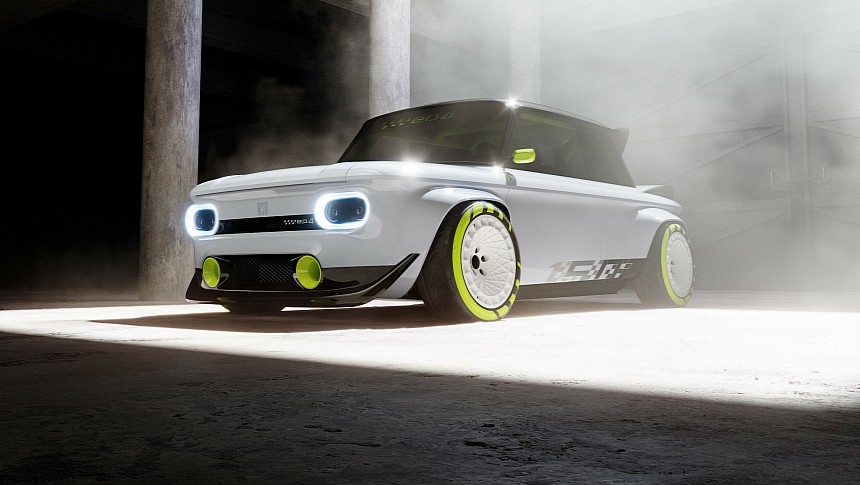The Audi EP4 is this cute 1970s-inspired car that marks the 150th anniversary of the Neckarsulm site in Germany. For the project, the trainees’ team used e-tron and Q7 TFSI e Quattro components.
A team of 12 apprentices worked on the Audi EP4, where the E stands for electric drive, while the P4 is a reference to the NSU Prinz 4, a car that was produced in Neckarsulm by NSU Motorenwerke between 1961 and 1973. Audi has been manufacturing cars over there for around 100 years.
The trainees wanted to build a car that looked cool, but would, at the same time,o be appropriate to celebrate the 150th anniversary of the production center. So they chose a 1971 NSU Prinz 4 as a base.
The project launched back in January with team meetings between trainees, trainers, and project managers, exchanging views on what they were planning to do. The trainees were first tasked to build a solid foundation for the conversion. One of the challenges they came across was the rust that affected the over 50-year old NSU Prinz 4.
The body and paint specialists managed to get rid of it and painted the car in Suzuka Grey and Brilliant Black, also fitting the lettering “150” to the sides. Meanwhile, the future mechanics worked on the powertrain, battery, and suspension, which had to be retuned to fit the new powertrain.
They extracted the original two-cylinder 30-horsepower (30-PS) gasoline engine and replaced it with a 236-horsepower (239-PS) electric motor coming from a 2020 Audi e-tron. The donor of the battery was a plug-in hybrid Audi Q7 TFSI e Quattro. The unit found room under the front hood of the EP4, where the old boxy NSU Prinz used to have the fuel tank. It obviously doesn’t need it anymore.
They fitted a wide air intake at the bottom of the bumper, while the tailgate also helps with the cooling.
Modifying the design of the retro-styled Prinz was tricky for the trainees. They had to make it clear that the new car was based on it, but also make it look futuristic. A modified floor pan from an Audi A1, including brakes and axles, did the base trick. Using 3D printing, they widened the body, fitted muscular fenders, and mounted wide wheels with modern performance tires. The hood is made of carbon fiber. At the rear, there is a wing that is not attached to the bodywork, but directly to the roll cage.
As for the roll cage, it was painted in Signal Yellow, contrasting with the surfaces in black. There are “Recaro Podium” bucket seats on board as well, and the cabin has been stripped down to minimum. It is, after all a 1970s motor racing-inspired futuristic Audi.
The trainees wanted to build a car that looked cool, but would, at the same time,o be appropriate to celebrate the 150th anniversary of the production center. So they chose a 1971 NSU Prinz 4 as a base.
The project launched back in January with team meetings between trainees, trainers, and project managers, exchanging views on what they were planning to do. The trainees were first tasked to build a solid foundation for the conversion. One of the challenges they came across was the rust that affected the over 50-year old NSU Prinz 4.
The body and paint specialists managed to get rid of it and painted the car in Suzuka Grey and Brilliant Black, also fitting the lettering “150” to the sides. Meanwhile, the future mechanics worked on the powertrain, battery, and suspension, which had to be retuned to fit the new powertrain.
They extracted the original two-cylinder 30-horsepower (30-PS) gasoline engine and replaced it with a 236-horsepower (239-PS) electric motor coming from a 2020 Audi e-tron. The donor of the battery was a plug-in hybrid Audi Q7 TFSI e Quattro. The unit found room under the front hood of the EP4, where the old boxy NSU Prinz used to have the fuel tank. It obviously doesn’t need it anymore.
They fitted a wide air intake at the bottom of the bumper, while the tailgate also helps with the cooling.
Modifying the design of the retro-styled Prinz was tricky for the trainees. They had to make it clear that the new car was based on it, but also make it look futuristic. A modified floor pan from an Audi A1, including brakes and axles, did the base trick. Using 3D printing, they widened the body, fitted muscular fenders, and mounted wide wheels with modern performance tires. The hood is made of carbon fiber. At the rear, there is a wing that is not attached to the bodywork, but directly to the roll cage.
As for the roll cage, it was painted in Signal Yellow, contrasting with the surfaces in black. There are “Recaro Podium” bucket seats on board as well, and the cabin has been stripped down to minimum. It is, after all a 1970s motor racing-inspired futuristic Audi.





